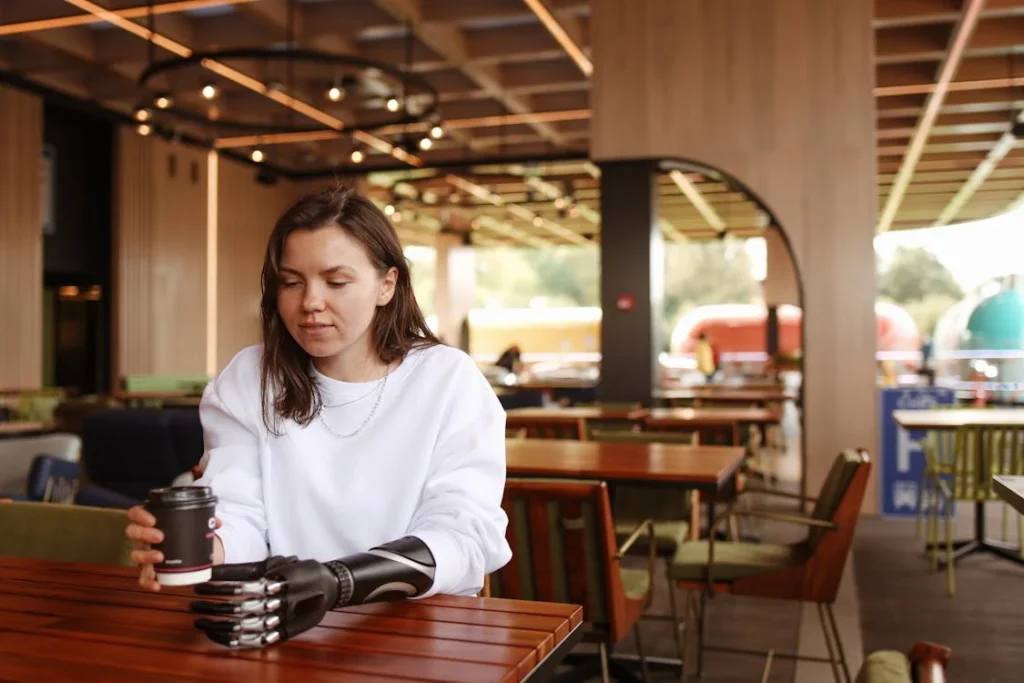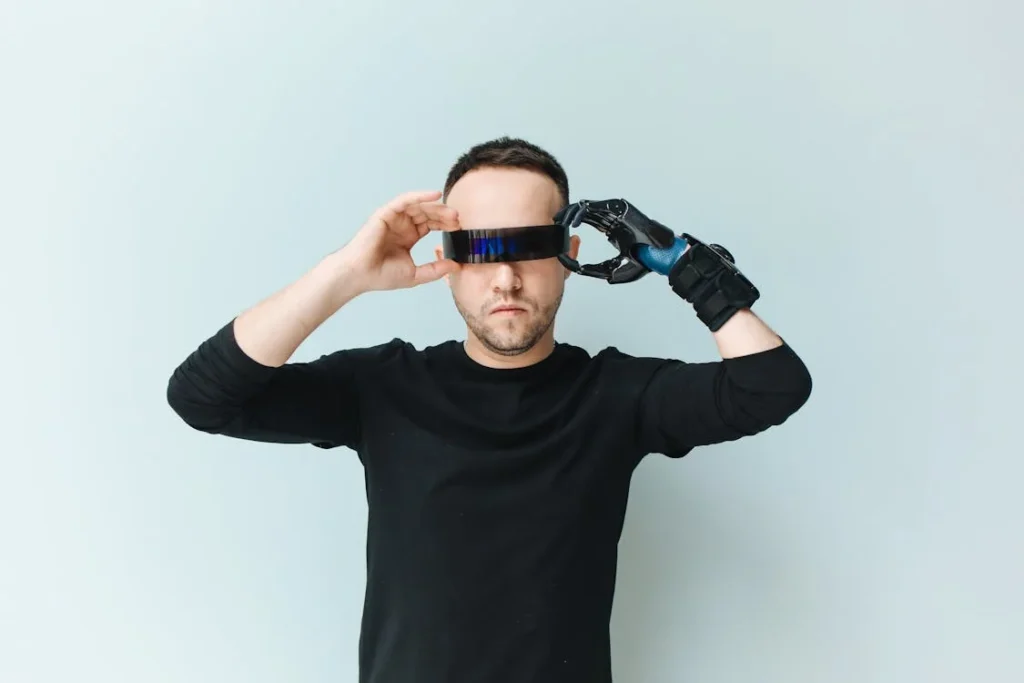In today’s world, bionic hands are more than just mechanical tools. They are intelligent extensions of the body, guided not by buttons or joysticks, but by the user’s own muscle signals. At the core of this innovation lies a powerful science — Electromyography (EMG).
This article breaks down how EMG works to give prosthetic hands their smart, responsive grip. We’ll walk through it step by step, in plain words, and explain how muscle signals, sensors, and engineering come together to restore something truly special — the power to hold, lift, grasp, and feel in control again.

Understanding What EMG Actually Means
Turning Muscle Signals Into Motion
Electromyography — or EMG — sounds complex, but its basic idea is very simple. Every time you move a muscle, it produces a small electrical signal.
Even something as tiny as trying to wiggle your fingers sends a little burst of energy through your skin. These signals are invisible, but they can be measured.
Now imagine a sensor sitting gently on your skin, listening for these signals. That’s what EMG does. It detects the electrical activity from your muscles and sends that information to a device — like a prosthetic hand — which then decides how to respond.
When someone wears a modern bionic hand, small EMG sensors are placed inside the socket of the prosthesis, resting against the surface of their residual limb.
When they think about moving their hand — like closing a fist or pinching something — the muscles in their forearm or upper arm still try to move, even if the hand itself is no longer there. EMG sensors pick up on those attempts.
The hand’s internal system reads those signals and interprets what the person wants to do. Should the fingers close? Should the grip tighten? Should the thumb move in a different position?
All of these decisions start with the tiny pulses from muscles. That’s the core of EMG-driven grip control — using natural muscle behavior to control a robotic hand.
What makes this method so special is that it doesn’t require the user to learn a completely new way of thinking. They simply think about moving their missing hand the way they always did.
Their muscles respond, and the prosthesis does the rest. The movement becomes intuitive and natural — even though the mechanics behind it are incredibly advanced.
At Robobionics, we fine-tune our sensors to detect even the smallest EMG signals, ensuring that users with different muscle strength levels — whether from surgery, injury, or age — can still experience smooth, accurate grip control.

How the Grip Actually Works in Real-Time
From Signal to Action in the Blink of an Eye
Once the EMG sensors pick up a muscle signal, things start moving fast. The signal has to be captured, cleaned, understood, and then translated into finger movement — all in just a fraction of a second. That’s where real-time signal processing comes into play.
The very first thing the prosthetic hand’s system does is filter the signal. The human body creates all kinds of electrical activity — from nearby muscles, nerves, and even from outside sources like static electricity or radio waves.
So, the system has to isolate the signal that matters — the one that comes from the specific muscle trying to activate a grip.
After filtering, the hand’s control system reads the signal’s strength, duration, and shape. If the signal is strong and quick, it might mean the user wants to perform a firm, full grip.
If the signal is soft and short, it might mean a gentle pinch. The system uses algorithms — or a set of rules — to figure out what movement makes the most sense based on the signal.
Then the hand moves. Tiny motors in the fingers respond immediately, adjusting how far and how fast each finger bends. If the grip is meant to hold something fragile — like a paper cup — the hand moves slowly and applies less pressure.
If the grip is meant to carry something heavy, like a backpack, the fingers close tighter and with more power.
All of this happens in real time. From the moment your brain sends a message to your arm, to the moment the fingers of the prosthetic move — it takes less than a second.
This kind of speed is crucial in everyday life. No one wants to wait for their hand to “catch up” when they’re in the middle of doing something. Whether you’re grabbing a door handle, catching a falling phone, or stirring sugar into tea, the prosthetic must respond quickly and precisely.
Our engineers at Robobionics test every EMG response with real users in real-world settings. We make sure that the grip not only works, but feels smooth, confident, and reliable — like a real extension of your body.

Training the Hand to Understand You
Teaching Your Bionic Hand to Listen Better
Even though EMG signals come naturally from the user, the prosthetic hand still needs to learn how to understand them. After all, every person’s muscle signals are different — and sometimes even the same person’s signals can change throughout the day, based on mood, fatigue, or how the socket is fitting.
That’s why modern EMG-driven systems are designed to learn, adapt, and improve over time.
When a prosthetic user is first fitted with their bionic hand, they begin a process called calibration. This usually happens with the help of a prosthetist.
The user performs a few simple movements, like pretending to close their hand or flex a specific muscle. As they do, the EMG sensors record what that signal looks like. The system uses this as a “map” to understand how that user communicates with their muscles.
But calibration is not a one-time event. As the user wears their prosthesis more often, the system continues to learn from each movement.
If it notices that a certain pattern of signals always leads to a certain motion, it begins to respond faster and more accurately. This is called adaptive control — where the hand gets smarter the more it’s used.
Some of the most advanced EMG-driven systems use pattern recognition. Instead of just looking at one or two signals, they examine a wide pattern of muscle activity across multiple points. This allows for more complex decisions — like switching between grip modes without needing a physical button or app.
Over time, this means the user doesn’t need to think as hard. Grip control becomes natural. The user simply intends to grab a fork or pick up a book, and the hand understands what to do.
At Robobionics, we work closely with our users during this learning phase. We fine-tune each system to match not just the user’s body, but their lifestyle — whether they’re a student, office worker, athlete, or retiree. Our goal is to make the hand feel so natural that users stop thinking about the technology — and start living with it like it’s part of them.

Why EMG Grip Control Feels So Natural
The Beauty of Muscle Memory and Mind-Body Connection
One of the biggest reasons why EMG-driven grip control is changing lives is because it feels natural. Unlike older prosthetic systems where users had to push buttons or manually open and close their hand, EMG control simply follows what your body already knows how to do.
That’s because EMG taps directly into something called muscle memory. This isn’t memory in your brain — it’s more like a habit built into your muscles over time.
For example, if you’ve ever learned to type without looking at the keyboard or ride a bicycle without thinking, that’s muscle memory at work.
Even after limb loss, many people still have these muscle memories stored in their nervous system. The brain still knows how to tell the hand to close. The muscles still respond, even if the hand is no longer there. EMG systems simply listen in on that familiar conversation.
When a user moves their phantom limb — meaning the invisible hand that they can still feel — the EMG system picks up the effort and responds.
Over time, users begin to experience a strange and wonderful shift: they stop feeling like they’re operating a machine, and start feeling like the hand is truly theirs.
This is a major difference between EMG-driven systems and mechanical ones. With mechanical hands, users have to learn new ways to move. With EMG systems, the prosthesis learns your old ways and adapts to them. That shift not only improves usability — it also brings emotional comfort.
Many users say that EMG prosthetics help them feel “whole” again. The control feels organic. There’s less frustration. They don’t have to keep explaining or thinking about how to do something — they just do it.
At Robobionics, this human connection is our guiding principle. We don’t build machines. We build experiences. Every EMG hand we create is designed to bring back the feeling of natural control, restoring not just function, but confidence.

Real-World Applications of EMG Grip Control
How Everyday Life Becomes Easier and More Confident
What truly sets EMG-driven bionic hands apart is how well they adapt to real life. In the lab, things are clean and controlled. But in the real world, life is messy, fast, and unpredictable. EMG grip control is designed with that reality in mind.
Let’s walk through an ordinary day — and see just how extraordinary EMG grip control makes it.
In the morning, a user might start their day by brushing their teeth. The prosthetic hand automatically detects a small signal from the arm muscles, triggering a pinch grip to hold the toothbrush firmly. There’s no lag, no fiddling, just a smooth and steady grip that holds — not crushes — the brush.
During breakfast, the hand easily switches to a different grip for holding a cup. Thanks to EMG control, this switch is seamless. The user isn’t looking at their hand or double-checking every move. They simply think “grab the cup” — and the hand responds.
At work, grip control continues to shine. Holding pens, flipping notebook pages, or even shaking hands with a colleague feels natural. With EMG, there’s no need to rely on remote controls or awkward arm movements to make the hand do what it should. The user can focus on the task — not on managing the prosthesis.
One of the most beautiful things about EMG-based systems is how they reduce mental load. When you’re not constantly thinking about how to move your hand, you’re free to think about everything else — your job, your conversation, your plans for the evening. The hand just works.
In leisure time, grip modes driven by EMG allow for fine motor control — holding a paintbrush, playing a simple instrument, or tossing a light ball with a friend. It opens up hobbies that once felt impossible.
And then there are moments you can’t plan for — like picking up a dropped item or reacting quickly to catch something. EMG systems respond immediately, giving the user that sense of trust in their prosthetic. Trust that it will work, and work when it matters most.
We’ve seen users carry their children, help in the kitchen, ride bikes, and even go rock climbing — all thanks to the intuitive response of EMG grip control.
These stories aren’t exceptions anymore. They’re becoming the norm. That’s the real success of EMG technology — when it blends so seamlessly into life that people forget it’s even there.
Common Challenges and How Users Overcome Them
Tackling the Learning Curve With Confidence
While EMG grip control brings incredible freedom, it’s also a learning journey — especially in the beginning. The first few weeks with a new EMG-enabled hand can feel unfamiliar. But with time, support, and the right mindset, users move from awkward to confident.
One of the first hurdles is signal clarity. Everyone’s muscle signals are different. Some are naturally strong and easy to detect. Others might be weaker or inconsistent due to surgery, scar tissue, or just fatigue. In these cases, the hand may not respond as expected — or worse, it may misread the user’s intent.
This is where professional signal training becomes essential. During early fittings, the prosthetist teaches users how to produce clean, repeatable muscle contractions. Sometimes that means changing the way a muscle is activated. Other times, it means adjusting the electrode placement to get a better reading.
Some users experience false positives — the hand moves when they didn’t mean it to. This usually happens when the EMG system is too sensitive, or the person tenses up due to stress or temperature changes. The solution lies in refining the system’s signal filters and thresholds. Our hands at Robobionics include fine-tuning software that helps adapt the sensitivity based on real-world conditions.
Then there’s muscle fatigue. New users often find their arm getting tired quickly, especially during long days or repetitive tasks. That’s because they’re still learning how much effort is needed to trigger a grip — and often, they’re doing more than they need to.
We work with our users to reduce this by teaching efficient signal patterns. Over time, the body learns to use less energy, just like how a beginner typist eventually stops hitting keys too hard. The goal is effortless control.
Some users also struggle with grip switching, especially when they want to move from one grip mode to another quickly. EMG control makes this possible — but it takes practice. At Robobionics, we often recommend specific training games or app-based exercises that help reinforce the timing and muscle coordination needed for smooth transitions.
Finally, there’s the emotional challenge. It can be frustrating to feel like the hand isn’t cooperating or like you’re failing. We remind users: this is completely normal. Every user — even the most skilled — started at zero. With patience, repetition, and support, every EMG user becomes fluent in their new language of movement.

Involving Caregivers in the Journey
Building a Circle of Support Around the User
Behind every successful prosthetic journey is a circle of support. For many users, that includes a spouse, parent, sibling, therapist, or close friend. These caregivers play a quiet but powerful role in helping EMG grip control become part of daily life.
One way caregivers help is by being a second set of eyes. During the early days of using the prosthetic, a caregiver can observe when the grip is working well — and when it’s not. They can notice patterns, help track what muscle actions trigger certain movements, and even suggest grip modes that suit particular daily tasks.
They also help during practice sessions. Learning EMG control involves repetition — trying the same movement over and over until it feels right. Having someone supportive nearby to offer encouragement, or to hold items for practice, makes a big difference.
Caregivers often manage technical tasks too — like ensuring the prosthesis is charged, the app is synced, or updates are installed. For users who aren’t tech-savvy, this lightens the load and builds confidence.
Emotionally, caregivers help in ways that technology never could. When a user feels discouraged, self-conscious, or unsure, a familiar voice saying “You’re doing great” can turn the whole day around.
At Robobionics, we encourage caregiver involvement right from the start. We offer family-friendly training guides, videos, and support calls that empower caregivers to understand how EMG grip control works — so they can step in and support effectively without taking over.
What we often find is that when the user and caregiver learn together, the experience becomes smoother, stronger, and even more joyful. It’s not just about fitting a hand. It’s about building a life around it.
The Future of EMG Grip Control
Smarter, Faster, and Even More Personal
As powerful as EMG-driven prosthetics are today, we’re just scratching the surface of what’s possible. The future holds even more promise — and it’s coming faster than you think.
One of the most exciting developments is multi-channel EMG systems. Instead of just two sensors on a limb, future bionic hands may use up to eight or more. This will allow the hand to detect even more complex signals, leading to finer, more intuitive grip control — like rotating the wrist or moving fingers independently.
Artificial intelligence is also playing a bigger role. Some prototypes now use machine learning to study each user’s signal patterns and predict actions even before the signal is fully sent. That means faster reaction times, fewer errors, and an almost telepathic level of control.
In the next few years, we expect to see sensory feedback systems become more common. This means the hand doesn’t just move — it sends signals back to the user.
Imagine being able to feel how hard you’re squeezing something, or whether the object you’re holding is smooth or textured. That kind of feedback completes the loop between the brain and the hand, making the prosthesis feel even more like a real limb.
Another frontier is wireless EMG sensors — compact, skin-friendly patches that communicate with the prosthesis via Bluetooth. These reduce the need for heavy sockets and allow for sleeker, more breathable designs. They’re also ideal for kids or active users who need more flexibility.
And finally, affordability is improving. At Robobionics, we’re working hard to bring these advanced features to users across India — not just in metro cities but in small towns and rural regions too. We believe every person deserves access to intelligent grip control, regardless of income or location.
We’re entering a new era of prosthetic care — one where technology listens, learns, and adapts to you. The future of EMG is personal, precise, and deeply human.
Conclusion
EMG-driven grip control is more than just technology. It’s the quiet, powerful science that brings movement back into lives that had paused. It transforms prosthetic hands from lifeless tools into responsive, intelligent companions that listen to the body and obey with grace. It puts choice back into the hands of those who had lost it.
For someone waking up with a bionic hand for the first time, EMG doesn’t scream for attention. It simply waits — listening to the muscles, responding when needed. Whether it’s the gentle act of lifting a spoon, the firm hold of a steering wheel, or the quick grab of a falling phone, EMG responds instantly and intuitively.
This journey isn’t about replacing a limb. It’s about restoring confidence, dignity, and independence. It’s about allowing people to live, work, care, create, and connect — without worrying whether their hand will cooperate. EMG gives that assurance. Quietly. Reliably. Every day.
At Robobionics, we don’t just engineer hardware. We engineer trust. Every hand we build is the product of years of testing, learning, and listening — not only to signals from muscles but to voices from the community. We listen to the mother who wants to braid her daughter’s hair again. To the student who wants to hold a pen. To the grandfather who just wants to pour his own cup of tea.
These stories shape our designs. They push us to make hands that aren’t just smart, but sensitive. Not just strong, but subtle. Not just fast, but forgiving — because we know real life doesn’t happen in straight lines.
If you or someone you know is exploring the world of prosthetics, we invite you to look beyond the mechanics. Ask how the hand learns. Ask how it listens. Ask how it understands you — not just your needs, but your habits, your frustrations, your triumphs.
That’s where EMG shines. It builds a bridge between what your body remembers and what your future demands. It turns your muscle signals into choices. And those choices turn into action, freedom, and identity.
We believe this is just the beginning. As we refine our EMG systems, expand our grip control options, and bring down costs to serve every corner of India, our mission remains the same: to give every user the most natural, responsive, and human experience possible.
Because at the end of the day, this is not just about science. It’s about people. It’s about motion — not just in hands, but in life itself.
If you’d like to explore how EMG bionic hands could help you, a loved one, or your patients, reach out to the Robobionics team. We’re not just building hands. We’re building hope — one grip at a time.



